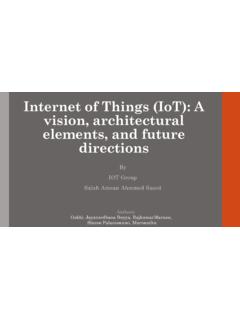Transcription of A Survey of Data Mining and Machine Learning Methods for ...
1 A Survey of Data Mining and Machine Learning Methods for cyber security intrusion detection 2017. 09. 18. Presented by Pradip Kumar Sharma The main focus of this presentation is on Survey of Machine Learning (ML) and data Mining (DM) Methods for cyber analytics in support of intrusion detection . The data are so important in ML/DM approaches, some well-known cyber data sets used in ML/DM are described. Discussion of challenges for using ML/DM for cyber security is presented, and some recommendations on when to use a given Methods are provided. cyber crime encompasses any criminal act dealing with computers and networks (called hacking). The computer used as an object or subject of crime. Malicious programs, Illegal imports, Computer Vandalism. A major attack vector of cyber Crime is to exploit broken software. Set of technologies, processes and practices designed to protect networks, computers, programs and data from attack, damage or unauthorized access.
2 Composed of computer security system and network security systems. A major part of cyber security is to fix broken software cyber security will be massively improved if there are less broken software cyber Crime will be massively reduced if there are less broken software The Coin: Broken/Complex Software cyber security : One side of the coin cyber Crime: Other side of the coin Decrease in broken software = Increase in good cyber attacks (intrusions) are actions that attempt to bypass security mechanisms of computer systems. They are caused by: Attackers accessing the system from Internet Insider attackers - authorized users attempting to gain and misuse non-authorized privileges Typical intrusion scenario Generally two types of cyber attacks in the computer networks: attacks that involve multiple network connections (bursts of connections). attacks that involve single network connections Single connection attack security mechanisms always have inevitable vulnerabilities Current firewalls are not sufficient to ensure security in computer networks security holes caused by allowances made to users/programmers/administrators Insider attacks Multiple levels of data confidentiality in commercial and government organizations needs multi-layer protection in firewalls intrusion detection : intrusion detection is the process of monitoring the events occurring in a computer system or network and analyzing them for signs of intrusions, defined as attempts to bypass the security mechanisms of a computer or network ( compromise the confidentiality, integrity, availability of information resources ).
3 intrusion detection System (IDS). combination of software and hardware that attempts to perform intrusion detection raise the alarm when possible intrusion happens Fig : intrusion detection System There are three main types of cyber analytics for supporting IDS : Misuse Based. Anomaly Based. Hybrid. Misuse Based detection Designed to detect known attacks by using signatures of those attacks. Effective detecting known type of attacks without generating false alarms. Frequent manual updating of data is required. Cannot detect Novel (Zero-day) attacks. Anomaly Based detection Identifies the anomalies from normal behavior Able to detect Zero-Day Attack Profiles of normal activity are customized for every system Hybrid detection Combination of misuse and anomaly detection . Increases the detection rate and decreases the false alarm generation. Machine Learning : It gives ability to computers to learn without being explicitly programmed.
4 Need of goal from domain There should be three phases : Training Validation Testing Data Mining : Focused on discovery of previously unknown and important properties in data. Used for extracting patterns from data Summary Statistics: Quantifies numbers Data Mining : Explains patterns Machine Learning : Predicts with models Artificial Intelligence: Behaves and reasons Fig : CRISP-DM Model The cyber security data sets for DM and ML are given below : Packet Level Data Netflow Data Public Data Sets Protocols are used for transmission of packet through network. The network packets are transmitted and received at the physical interface. Packets are captured by API in computers called as pcap. For Linux it is Libpcap and for windows it is WinPCap. Ethernet port have payload called as IP payload. Introduced as a router feature by Cisco. Version 5 defines unidirectional flow of packets. The packet attributes are : ingress interface, source IP address, destination IP address, IP protocol, source port, destination port and type of services.
5 Netflow includes compressed and preprocessed packets. The Defense Advance Research Projects Agency (DARPA) in 1998 and 1999 data sets are mostly used. This Data Set has basic features captured by pcap. DARPA defines four types of attacks in 1998 : DoS Attack, User to Root (U2R) Attack, Remote to Local (R2L) Attack, Probe or Scan. Artificial Neural Networks (ANN). Association Rules & Fuzzy Association Rules Bayesian Network Clustering Decision Tree Ensemble Learning Evolutionary Computation Hidden Markov Model Inductive Learning Nalve Bayes Sequential Pattern Mining Support Vector Machine Network of Neurons Output of one node is input to other. ANN can be used as a multi-category classifier of intrusion detection Data processing stage used to select 9 features: protocol ID, source port, destination port, source address, destination address, ICMP type, ICMP code, raw data length and raw data. It's a probabilistic graphical model that represents the variables and the relationships between them.
6 The network is constructed with nodes as the discrete or continuous random variables and directed edges as the relationships between them, establishing a directed acyclic graph. The child nodes are dependent on their parents. Each node maintains the states of the random variable and the conditional probability form. Bayesian networks are built Fig : Bayesian Network for Attack Signature detection using expert knowledge or using ef cient algorithms that perform inference. A decision tree is a tree-like structure that has leaves, which represent classi cations and branches, which in turn represent the conjunctions of features that lead to those classi cations. An exemplar is labeled (classi ed) by testing its feature (attribute) values against the nodes of the decision tree. The best known Methods for automatically building decision trees are the ID3 and algorithms. Advantages: Decision trees are intuitive knowledge expression, high classi cation accuracy, and simple implementation.
7 Disadvantage: Data including categorical variables with a different number of levels, information gain values are biased in Fig : An Example Decision Tree favor of features with Markov chains and Hidden Markov Models (HMMs) belong to the category of Markov models. A Markov chain is a set of states interconnected through transition probabilities that determine the topology of the model. An HMM is a statistical model where the system being modeled is assumed to be a Markov process with unknown parameters. In this example, each host is modeled by four states: Good, Probed, Attacked, and Compromised. The edge from one node to another represents the fact that, when a host is in the state indicated by the source node, it can transition to the state indicated by the destination node. Fig : Hidden Markov Model We can use Deep Learning method to achieve more accuracy for cyber security intrusion detection . But, again processing time of data will be a big challenge.
8 To address this issue, we may use graph partition method to train and update the dataset in partial way. Here, we discuss the literature review of ML and DM. Methods used for cyber security . Different ML and DM techniques in the cyber domain can be used for both Misuse detection and Anomaly detection . There are some peculiarities of the cyber problem that make ML and DM Methods more difficult to use. They are especially related to how often the model needs to be retrained. In most ML and DM applications, a model ( , classi er) is trained and then used for a long time, without any changes. Buczak, A. L., & Guven, E. (2016). A Survey of data Mining and Machine Learning Methods for cyber security intrusion detection . IEEE. Communications Surveys & Tutorials, 18(2), 1153-1176.











